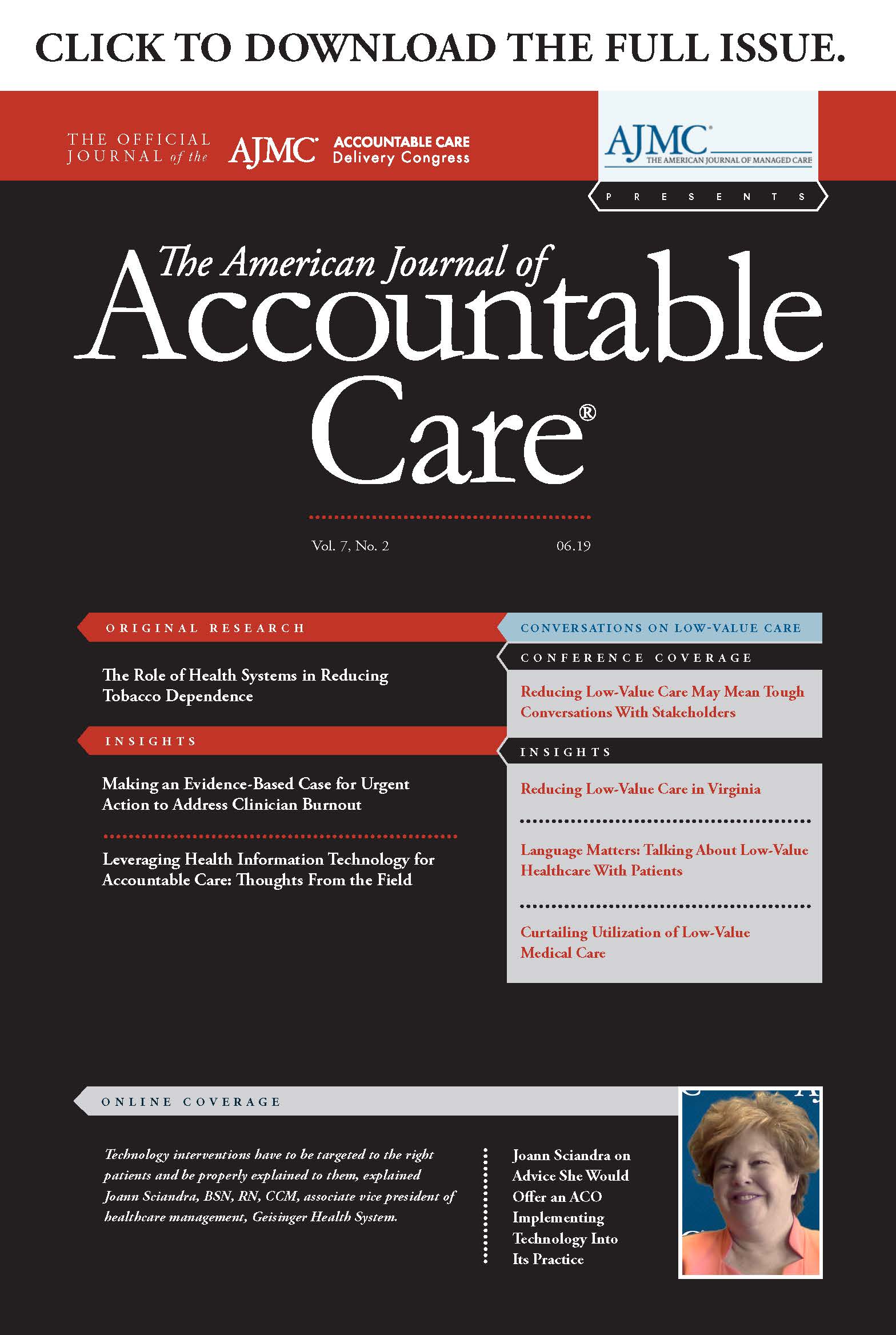- Center on Health Equity and Access
- Clinical
- Health Care Cost
- Health Care Delivery
- Insurance
- Policy
- Technology
- Value-Based Care
Reducing Low-Value Care in Virginia
Virginia is currently focused on creating a collaborative, data-informed process to reduce the use of low-value services and care and better serve patients.
The American Journal of Accountable Care. 2019;7(1):20-21The conversation around the overuse of unnecessary or low-value care is an important one, and here in Virginia, it is one we have been engaged in for a while. Through the work of the nonprofit Virginia Center for Health Innovation (VCHI) and numerous partners, identifying opportunities to eliminate or reduce the use of low-value services demonstrates a potential savings of more than $500 million annually in Virginia.1 The next step is to move from identification efforts to reduction efforts. Part of that shift involves getting people comfortable with the language of value and accepting what the science tells us: A significant portion of care is supported by outdated paradigms or practices that have been supplanted by new data and new approaches.
In 2018, Virginia expanded Medicaid, and to date, we have more than 280,000 Virginians newly enrolled. Many of these individuals now have health coverage for the first time in their adult lives for wellness checkups, trips to the emergency department, prescriptions, behavioral health and addiction services, and more. When we have been talking for so many years about the need to expand access, how do we suddenly shift the conversation to reducing low-value care?
For some, any conversation about value and cost is a conversation about reducing services and access. Instead, reducing low-value care is about shifting the focus onto what sort of care we are providing and making sure that individuals are getting not only access to quality-based care but also the right care for them in the right setting. A common refrain we hear on this issue is that we always thought more was better; however, we are learning that this is not always the case. Being strategic is better: looking at the data, looking at which tests and procedures the patient really needs, reducing unnecessary costs, and protecting the patient’s safety at all times.
In Virginia, we have been lucky to have not just the data resources but also the political will to look at what is working and what is not and find out where we need to act. We know delivery system reforms that contain or reduce costs and improve quality can particularly benefit underserved populations, and states can be major drivers of this type of reform. We are committed to overcoming disparities in Medicaid while at the same time increasing access.
In March, Governor Ralph Northam announced that the VCHI received a $2.2 million grant from Arnold Ventures to create a statewide pilot aimed at reducing the provision of low-value healthcare in Virginia. It will start by employing a 2-part strategy to first reduce 7 sources of provider-driven low-value care and will then prioritize a next set of consumer-driven measures for phase 2. Part 1 of the strategy calls for the formation of a large-scale health system learning community. This learning community will engage 6 health systems and 3 clinically integrated networks representing more than 900 practice sites from 4 regions of Virginia. Part 2 of the strategy will see the creation of an employer task force on low-value healthcare. By engaging employers—especially larger ones that are self-insured—on the concepts of identifying and reducing low-value care, we will have a great opportunity to begin benefit redesign that enhances the reduction of low-value services.
Reducing the use of low-value care will require a collaborative, data-informed process. We know that there is a great deal of work ahead of us, but we think reducing low-value care is one of the best ways to make sure higher-value care is affordable. The keys to our success will be developing comfort across the commonwealth with candid discussions about value and costs, as well as demonstrating that, through collaborative efforts, we can indeed significantly reduce services of no or low value.Author Affiliation: Secretary of Health and Human Resources, Commonwealth of Virginia, Richmond, VA.
Source of Funding: None.
Author Disclosures: The author reports no relationship or financial interest with any entity that would pose a conflict of interest with the subject matter of this article.
Authorship Information: Concept and design; drafting of the manuscript; and critical revision of the manuscript for important intellectual content.
Send Correspondence to: Daniel Carey, MD, Secretary of Health and Human Resources, Commonwealth of Virginia, Patrick Henry Building, 1111 E Broad St, Richmond, VA 23219. Email: daniel.carey@governor.virginia.gov.REFERENCE
1. Mafi JN, Russell K, Bortz BA, Dachary M, Hazel WA Jr, Fendrick AM. Low-cost, high-volume health services contribute the most to unnecessary health spending. Health Aff (Millwood). 2017;36(10):1701-1704. doi: 10.1377/hlthaff.2017.0385.


